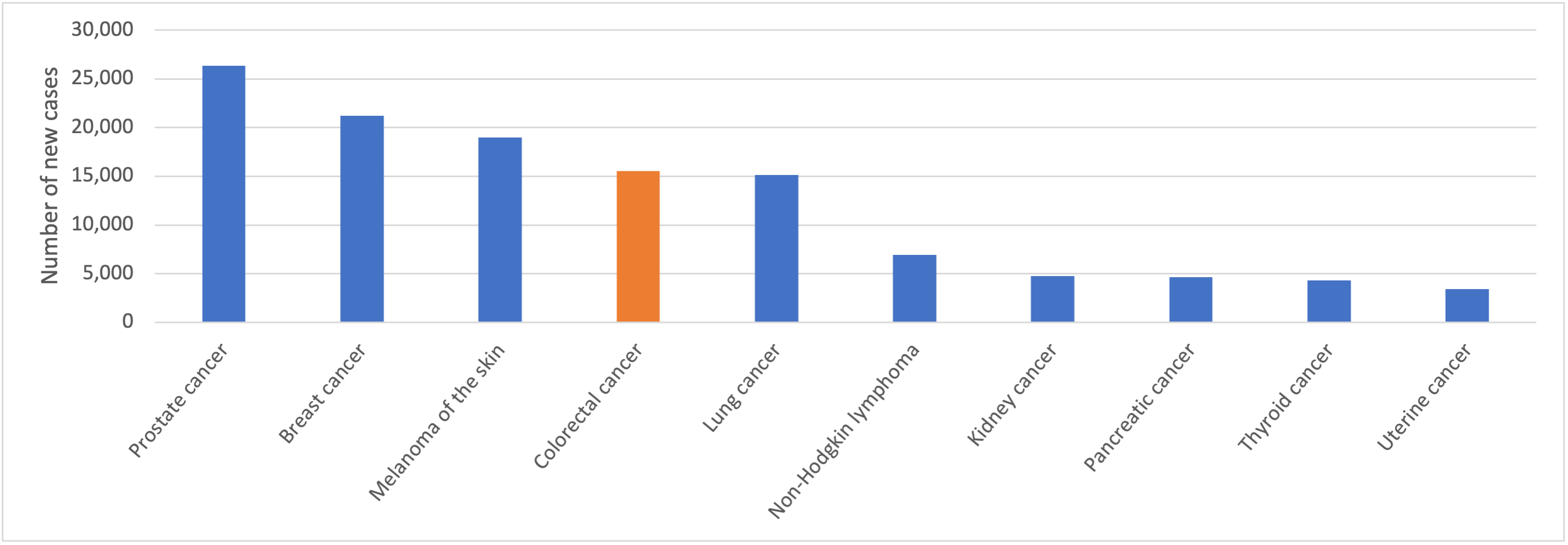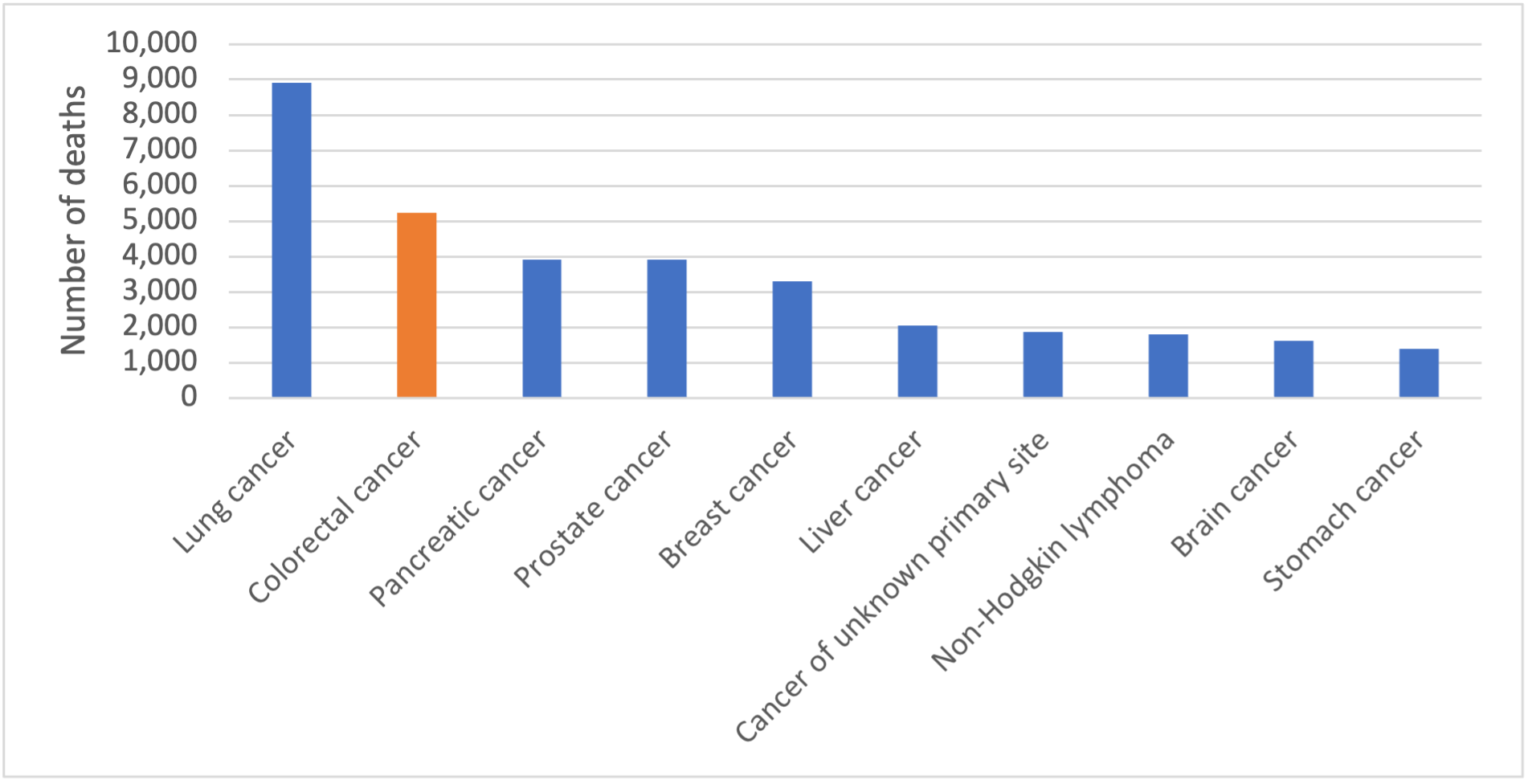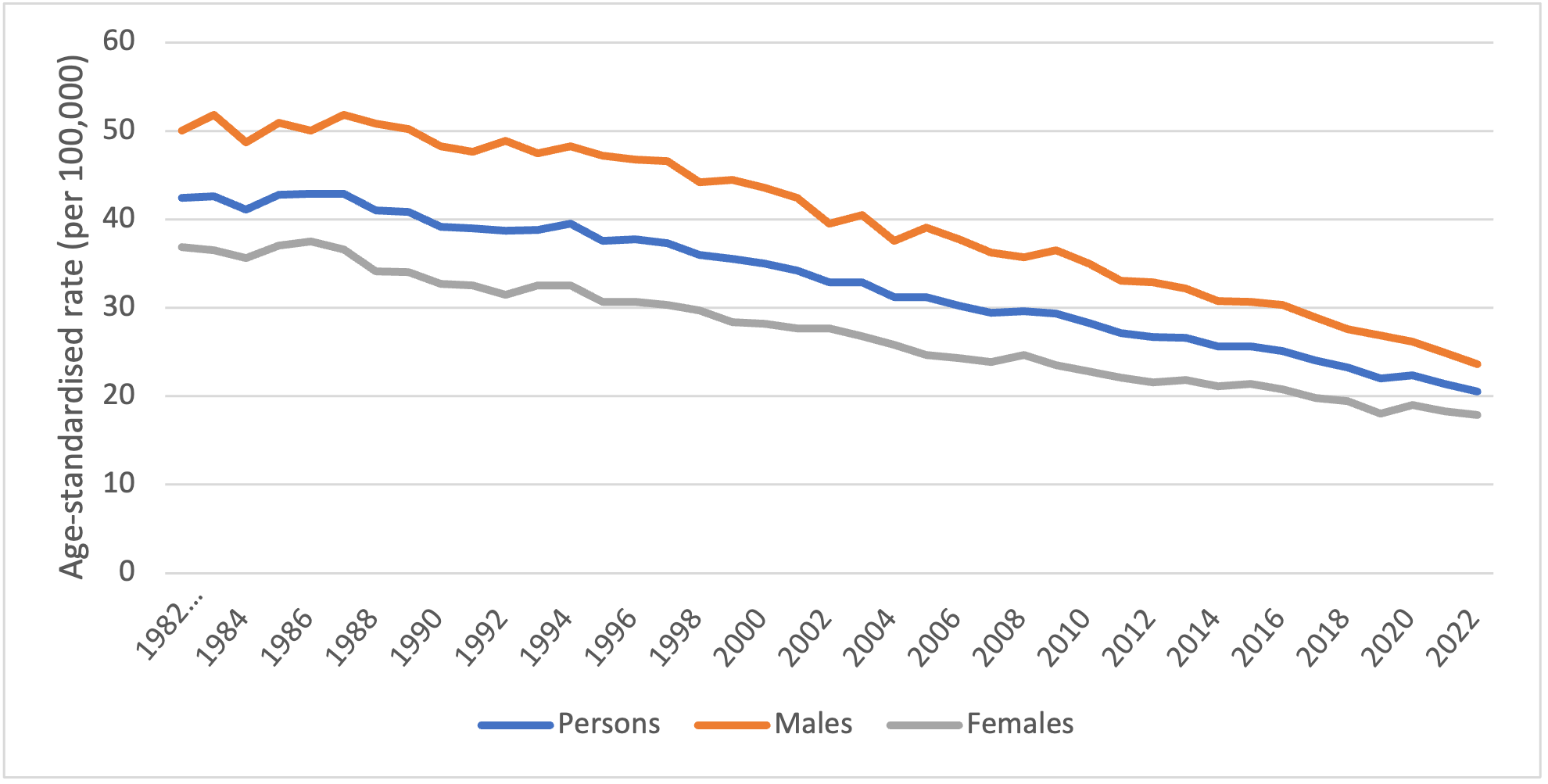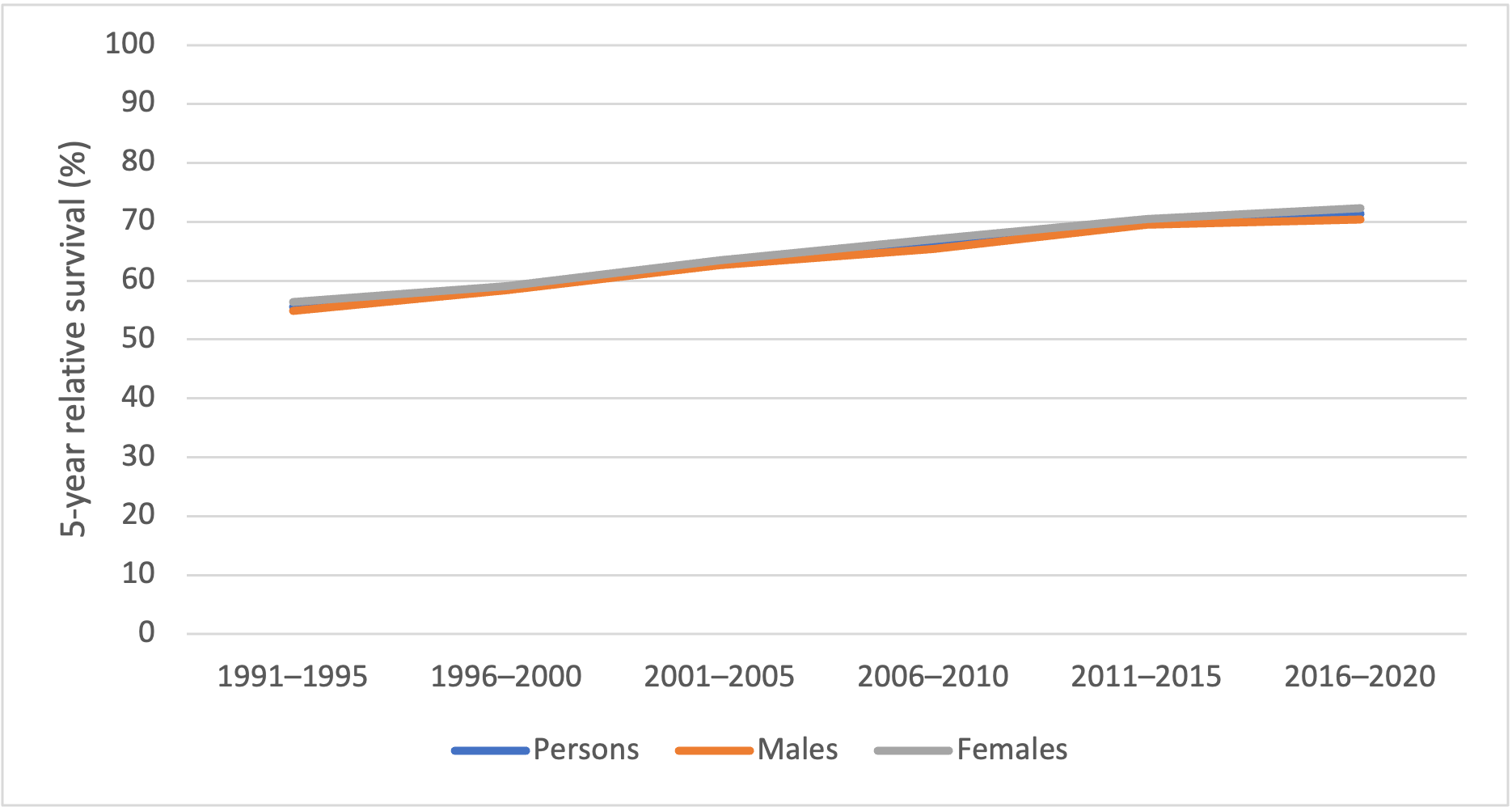The following material has been sourced from the Australian Institute of Health and Welfare
Colorectal cancer incorporates ICD-10 cancer codes C18 (Malignant neoplasm of colon), C19 (Malignant neoplasm of rectosigmoid junction) C20 (Malignant neoplasm of the rectum), and C26 (Malignant neoplasm of other and ill-defined digestive organs): Incidence (C18–C20), mortality (C18–C20, C26.0).
Estimated number of new cases of colorectal cancer diagnosed in 2024
15,542 = ![]() 8,205 males +
8,205 males + ![]() 7,337 females
7,337 females
Estimated % of all new cancer cases diagnosed in 2024
9.2%
Estimated number of deaths from colorectal cancer in 2024
5,239 = ![]() 2,730 males +
2,730 males + ![]() 2,509 females
2,509 females
Estimated % of all deaths from cancer in 2024
9.9%
Chance of surviving at least 5 years (2016–2020)
71%
People living with colorectal cancer at the end of 2020 (diagnosed in the 5 year period 2016 to 2020)
56,200
New cases
Colorectal cancer was the fourth most commonly diagnosed cancer in Australia in 2020. It is estimated that it will remain the fourth most commonly diagnosed cancer in 2024.
In 2020, there were 14,534 new cases of colorectal cancer diagnosed in Australia (7,833 males and 6,701 females). In 2024, it is estimated that 15,542 new cases of colorectal cancer will be diagnosed in Australia (8,205 males and 7,337 females). In 2024, it is estimated that a person has a 1 in 21 (or 4.8%) risk of being diagnosed with colorectal cancer by the age of 85 (1 in 19 or 5.1% for males and 1 in 23 or 4.4% for females).

Figure 1. Estimated cancer incidence in Australia, 2024
Notes
- Data sourced from AIHW Cancer Data in Australia 2024 web report and supplementary data tables
- More information about incidence rates for the most common cancers diagnosed can be found on the NCCI website in the ‘Cancer incidence’ section (https://ncci.canceraustralia.gov.au/diagnosis/cancer-incidence/cancer-incidence)
In 2020, the age-standardised incidence rate was 59 cases per 100,000 persons (67 for males and 51 for females). In 2024, it is estimated that the age-standardised incidence rate will be 57 cases per 100,000 persons (64 for males and 51 for females). The incidence rate for colorectal cancer is expected to increase with age, highest for those aged 85–89 years.

Figure 2. Age-standardised incidence rates for colorectal cancer cancer, 1982 to 2020, by sex
Notes
- Data sourced from AIHW Cancer Data in Australia 2024 web report and supplementary data tables
- Age standardised rates are standardised to the 2024 Australian Standard Population
- More information about incidence rates for colorectal cancer over time, by age, sex, Indigenous status, remoteness, and socioeconomic status (SES) can be found on the NCCI website in the ‘Cancer incidence’ section (https://ncci.canceraustralia.gov.au/diagnosis/cancer-incidence/cancer-incidence)
The number of new cases of colorectal cancer diagnosed increased from 6,991 (3,527 males and 3,464 females) in 1982 to 14,534 in 2020. Over the same period, the age-standardised incidence rate decreased from 74 cases per 100,000 persons (85 for males and 66 for females) in 1982 to 59 cases per 100,000 in 2020.
Deaths
In 2022, colorectal cancer was the second most common cause of cancer death in Australia. It is estimated that it will remain the second most common cause of death from cancer in 2024.
In 2022, there were 5,276 deaths from colorectal cancer in Australia (2,746 males and 2,530 females). In 2024, it is estimated that there will be 5,239 deaths (2,730 males and 2,509 females). In 2024, it is estimated that a person has a 1 in 74 (or 1.4%) risk of dying from colorectal cancer by the age of 85 (1 in 67 or 1.5% for males and 1 in 83 or 1.2% for females).

Figure 3. Estimated cancer mortality in Australia, 2024
Notes
- Data sourced from AIHW Cancer Data in Australia 2024 web report and supplementary data tables
- Two sources are used for cancer mortality reporting rankings (National Mortality Database and Australian Cancer Database). Mortality data reported for cancer of unknown primary site, liver cancer and stomach cancer in the chart above is from the Australian Cancer Database. Data from the National Mortality Database is presented in-text unless it is unavailable. More information can be found at AIHW interim guidelines (https://www.aihw.gov.au/reports/cancer/cancer-data-in-australia/contents/cancer-data-commentaries/interim-guidelines-choosing-which-mortality-data)
- More information about mortality rates for the most common causes of cancer death can be found on the NCCI website in the ‘Cancer mortality’ section (https://ncci.canceraustralia.gov.au/outcomes/cancer-mortality/cancer-mortality)
In 2022, the age-standardised mortality rate was 21 deaths per 100,000 persons (24 for males and 18 for females). In 2024, it is estimated that the age-standardised mortality rate will be 19 deaths per 100,000 persons (22 for males and 17 for females). The mortality rate for colorectal cancer is expected to increase with age.

Figure 4. Age-standardised mortality rates for colorectal cancer cancer, 1982 to 2022, by sex
Notes
- Data sourced from AIHW Cancer Data in Australia 2024 web report and supplementary data tables
- Age standardised rates are standardised to the 2024 Australian Standard Population
- More information about mortality rates for colorectal cancer over time, by age, sex, Indigenous status, remoteness, and socioeconomic status (SES) can be found on the NCCI website in the ‘Cancer mortality’ section (https://ncci.canceraustralia.gov.au/outcomes/cancer-mortality/cancer-mortality)
The number of deaths from colorectal cancer increased from 3,704 (1,873 males and 1,831 females) in 1982 to 5,276 persons in 2022. Over the same period, the age-standardised mortality rate decreased from 42 deaths per 100,000 persons (50 for males and 37 for females) in 1982 to 21 deaths per 100,000 in 2022.
Survival
In 2016–2020, individuals diagnosed with colorectal cancer had a 71% chance (70% for males and 72% for females) of surviving for five years compared to their counterparts in the general Australian population. Between 1991–1995 and 2016–2020, five-year relative survival for colorectal cancer increased from 56% to 71%.

Figure 5. 5-year relative survival for colorectal cancer, 1991–1995 to 2016–2020, by sex
Notes
- Data sourced from AIHW Cancer Data in Australia 2024 web report and supplementary data tables
- More information about 5-year relative survival rates for colorectal cancer over time, by age, sex, Indigenous status, remoteness, and socioeconomic status (SES) can be found on the NCCI website in the ‘Relative survival rate’ section (https://ncci.canceraustralia.gov.au/outcomes/relative-survival-rate/5-year-relative-survival)
Prevalence
At the end of 2020, there were 12,763 people living who had been diagnosed with colorectal cancer that year, 56,200 people living who had been diagnosed with colorectal cancer in the previous 5 years (from 2016 to 2020), and 160,668 people living who had been diagnosed with colorectal cancer in the previous 39 years (from 1982 to 2020).
For more information, see Colorectal cancer on the NCCI website
The National Cancer Control Indicators (NCCI) are a set of indicators across the continuum of cancer care, from Prevention and Screening through to Diagnosis, Treatment, Psychosocial care, Research and Outcomes. The NCCI website allows users to see visual representations of data on each indicator through interactive charts.




